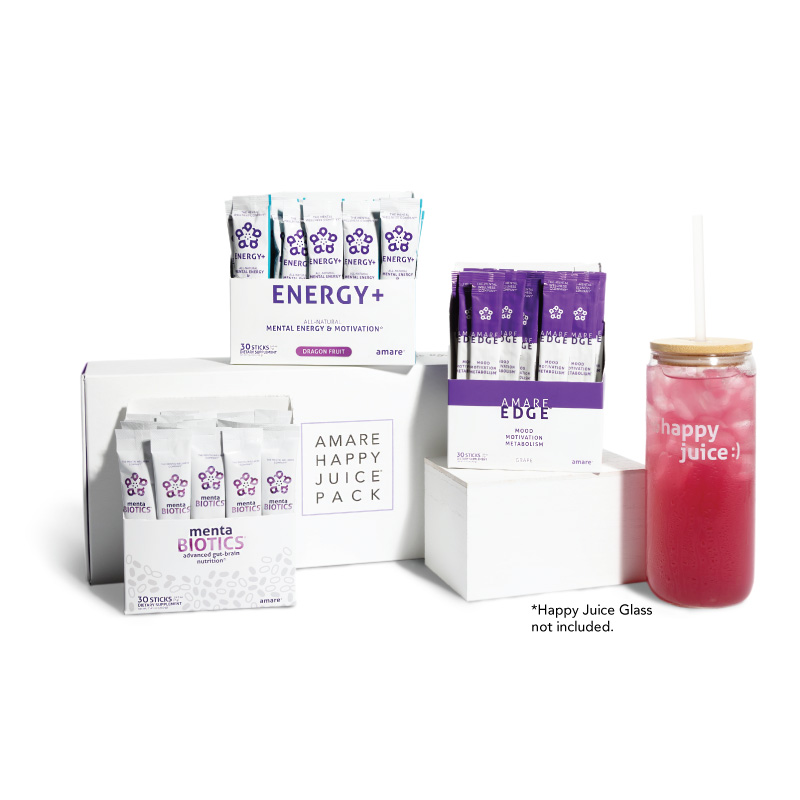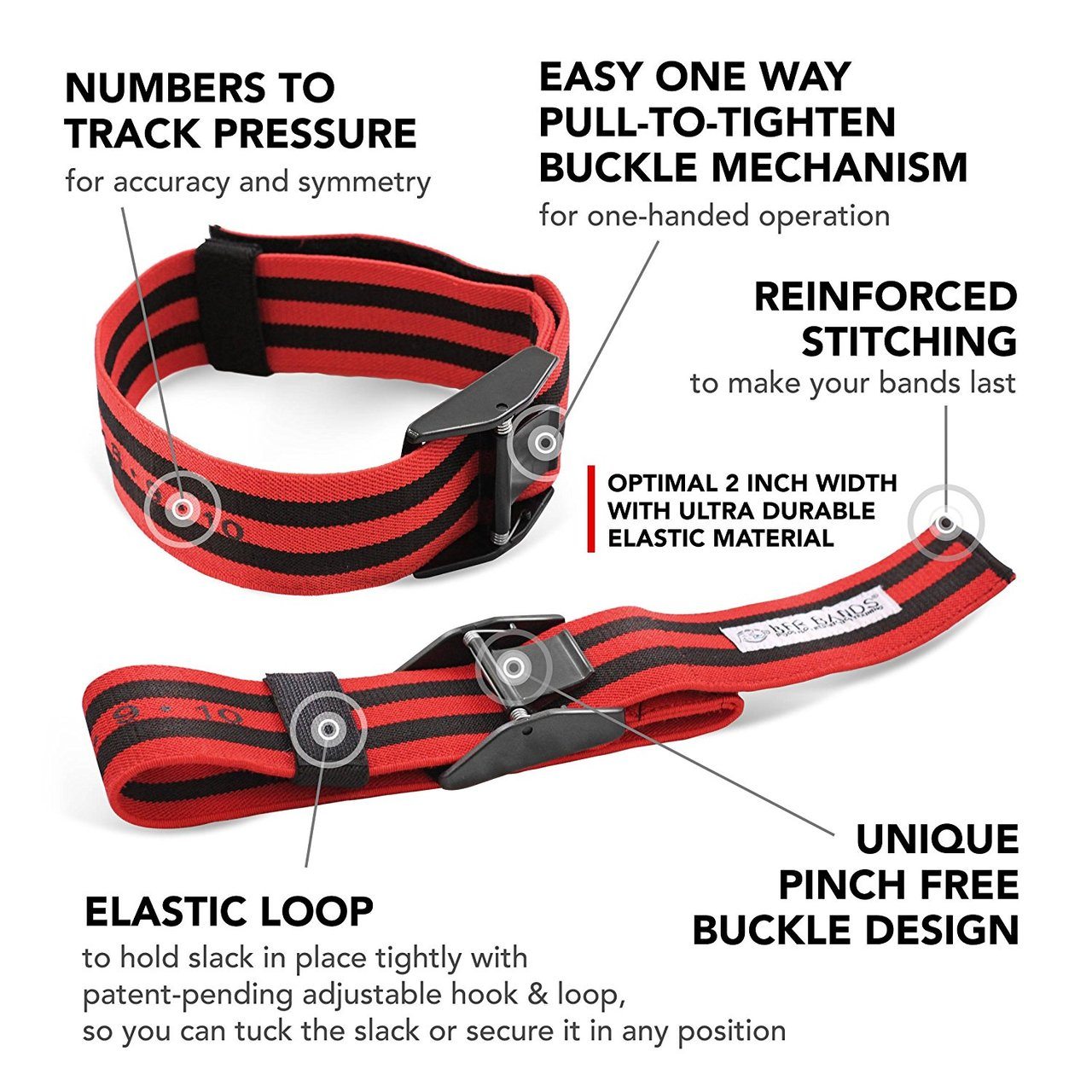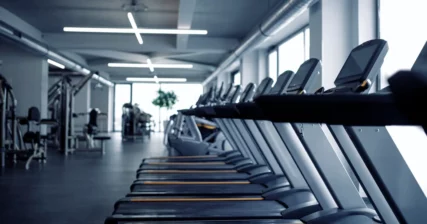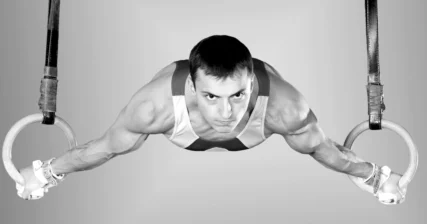Listen on: Apple Podcasts | Spotify
Blood flow restriction training (BFR), also known as occlusion training or KAATSU, might sound like some sort of hardcore training method reserved only for meatheads and serious athletes, but that’s hardly the case.
BFR could be the perfect addition to a training plan for weekend warriors, a way to help older adults build muscle and strength, and a great way to rehab injuries faster than ever.
If you’re a member of my online personal training program, VIGOR Training, you’ll see blood flow restriction training on in your workout program on occasion.

Feel Better Fast. Guaranteed.
Energy+, EDGE, and MentaBiotics make up the Happy Juice supplement stack, with ingredients clinically proven to:
- decrease anxiousness scores by 55%
- decrease irritability scores by 60%
- decrease fatigue by 64%
- decrease anger 54%
- decrease tension by 45%
- decrease confusion by 43%
- decrease overall distress by 49%
- increase good bacteria by 70%
- decrease negative mood by 105%
- increase positive mood by 211%
What Is Blood Flow Restriction Training?
Blood Flow Restriction Training (BFR) is a style of weight training that uses higher reps and lighter loads while wearing a compression strap, tourniquet, or blood pressure cuff, on your upper arms or legs, depending on what you’re working.
Unlike traditional strength training, which requires you to lift at least 70% of your one-rep (1RM), BFR training increases muscle mass and strength using only 20-50% of your 1RM.
When I first came across that single statement, I was skeptical. However, I’ve learned not to let my skepticism keep me from trying something new.
I ordered a pair of BFR Bands and gave them a try. I was impressed with the results, and loved being able to give my joints a break from the constant grind of heavier weight training.
If there’s a “magic” in BFR, it comes from metabolic stress.
The band, wrap, or cuff on your limb creates compression, occluding your veins while allowing for normal flow through your arteries.
The occlusion of your veins slows the return of low-oxygen, high-lactate blood flow from your arms or legs. The reduced flow also limits how quickly oxygen reaches your working muscle cells.
Like damming a flowing river, blood backs up, creating a “pump” in the muscle. This creates stress in your muscle cells, triggering numerous metabolic effects, leading to muscle and strength development.
If you want to skip over the technical details and get right to how to do BFR Training, jump to the bottom of this article.
For the sake of those who are skeptical, or even think this sounds scary, I’ll first go over the science behind BFR and the research supporting its use.
The Benefits Of Blood Flow Restriction Training
Blood flow restriction training increases strength and muscle mass at rates typically seen only by lifting heavy weight…without lifting heavy weight.
Traditional strength training programs use loads of at least 70% of an individual’s one rep max (1RM). Even young, fit, healthy athletes need a break from heavy training on occasion.
In addition, injuries, aging, surgery, and various diseases prevent people from using such heavy loads consistently.
Unfortunately, high-rep, lower-weight strength training doesn’t increase strength or muscle mass much…unless it’s done in combination with occlusion training.
When To Use Blood Flow Restriction Training
You can integrate BFR training into multiple different cases, such as:
- When traveling, and you don’t have access to all the equipment you’d normally use. You could do a BFR-only training session with the equipment typically found in a hotel.
- To rehab an injury, such as a torn biceps tendon or reconstructed ACL. Some research shows the effects can be transferred from one active limb to the other limb in cases of immobilization.
- To begin a strength training program as an older adult
- As a “deload” period to give your body a break, without losing strength or muscle mass
- During competition season to avoid impacting athletic performance, while still building muscle and strength
- To build or maintain strength and lean mass in people with degenerative diseases
- To slow the progression of cachexia or sarcopenia
Blood flow restriction can even slow the loss of muscle in an immobile limb without performing any exercise at all!
How Blood Flow Restriction Stimulates Muscle Growth
Occlusion training causes a buildup of lactate and other metabolic byproducts, limits oxygen delivery, causes significant cellular swelling, and increases mechanical tension on the muscles. The altered cellular environment stimulates numerous changes to cells, genes, and proteins, many of which aren’t yet fully understood.
The following is just some of what helps create the gains in muscle and strength.
BFR suppresses myostatin expression. Myostatin is a protein that suppresses muscle growth. Without myostatin, we’d literally walk around looking like the incredible hulk.
You’ll never suppress myostatin enough to get that big, but suppressing a little does help build muscle. If you want to see what happens when an animal lacks myostatin, check out this short clip from National Geographic, about the Belgian Blue Bull.
BFR increases anabolic hormones. Growth hormone levels have been shown to rise up to four times over baseline from occlusion training. Standard strength training typically only doubles growth hormone. Testosterone levels may also rise.
BFR increases protein synthesis. Just as protein synthesis increases following a bout of high-load strength training, low-load resistance training, performed to failure and while using blood flow restriction also stimulates protein synthesis.
The mammalian target of rapamycin (mTOR) pathway is also activated, as are mRNA genes related to muscle growth.
Blood Flow Restriction In Athletes
- Using an inflatable cuff, rugby players occluded limbs during bench press, squats, and pull-ups, using loads of 70% 1RM. They saw increases in strength, leg power, and 40-meter sprint performance.
- A group of American football players used BFR wraps for bench press and back squats at 20% of 1RM for four weeks. They saw 8% and 7% improvements, respectively, which is a really impressive strength gain in such a short period of time for such well-trained athletes.
- Elite level track athletes did BFR squats and leg curls for three sets of 15 reps, twice a day for eight days. In that short time, these well-conditioned athletes still saw a significant increase in muscle mass and a decrease in 30-meter sprint time.
- I found this study to be the most fascinating of all. Elite basketball players walked on a 5% incline at 4-6 km/hour, for five sets of three minutes each, with a one-minute rest between sets, six days per week for two weeks. By the end, they’d improved their VO2 Max and knee extension strength, compared with the control group.
Think about the potential with that last finding. If a well-trained athlete can improve his or her cardiovascular fitness and leg strength by walking on an incline using blood flow restriction, imagine the potential for older adults or people recovering from an injury!
One of the first recovery “steps” following ACL reconstruction is simply to walk. And in older people, the only thing they might be able to do in the beginning of a strength-building program is to walk. Walking while occluded increases leg strength and muscle mass.
A meta-analysis of occlusion training for musculoskeletal rehabilitation found that BFR produces better results than traditional training methods for those with ACL reconstruction, knee osteoarthritis, and adults with sarcopenia.
Risks of Blood Flow Restriction Training
For the most part, there’s very few risks involved in occlusion training. However, anyone with a pre-existing condition should always consult with their physician.
In those with hypertension, blood pressure does rise a little more during BFR training than in traditional training. Interestingly, it also falls to lower levels than traditional training after it’s done.
Aside from this nuance, blood flow restriction training seems to provide no greater risks than standard exercise or resistance training would create. In some ways, it could be safer, since the loads used are lower than traditional strength training.
How To Do Blood Flow Restriction Training
The original form of occlusion training was called KAATSU, which was developed in 1966 in Japan. The KAATSU training technique requires a special certification and a digital cuff that costs several thousand dollars.
If you’re vying for the Olympics, where every fraction of a second and ounce of muscle mass makes a difference, finding an experienced KAATSU practitioner would probably be worth the investment.
Researchers often use blood pressure cuffs to ensure all study participants use a consistent pressure.
You don’t have to make things that complicated. Elastic wraps or bands work as well for most people.
I use and recommend the ProX BFR Bands®. You won’t fully-appreciate their patent-pending design until you try to tighten the band around your upper arm, using only your other hand to do so. They’re worth the small investment.
The width of the band does make a difference, so if you think you’ll just go cheap and wrap a 4″ scarf around your limbs, don’t.
When the bands are too wide, they tend to occlude the arteries more than they should. Again, the goal is to occlude the veins, but not the arteries.
BFR Band Recommendation
The original bands I used were the BFR Pro bands. They were much easier than wrapping a band around my arms and legs, based on their patented strap. However, it was still a little awkward to get the strap on an arm one-handed. The new ProX makes it even easier to get the strap tightened one-handed.

Band Placement: The bands should be placed as high as possible on your working limbs. That means you get them into your armpit when you train upper body (arms, back, chest).
For legs (quads, hamstrings, calves, glutes, etc.), get them up into your groin. The band should be just under the fold between your glutes and hamstrings on your backside.
Occlusion training has a positive effect on the muscles below and above the cuff, so putting them on your upper arm does affect chest or back strength and muscle growth, as well as your biceps, triceps, etc.
Keep your clothing to a minimum. For upper body days, a sleeveless shirt is perfect.
On leg day, ladies would be best wearing yoga pants or spandex shorts. Guys, you could wear yoga pants too I suppose, although you’ll never see me in a pair. I can’t wrap my head around it. A pair of thin pair, baggy Lulu shorts works great.
The main thing is, you don’t want thick clothing under your wraps or bands as it makes the pressure less uniform, and you’ll end up with a chunk of clothing that bulks up and presses too hard under the cuff.
Band Tension: The purpose of the band is to occlude your veins without occluding your arteries. A tension of a 6 or 7 on a scale of 1-10 seems to work the best.
For you super-analytical types, I get that this is a “subjective” measure, but the research shows it’ll work just fine. You will appreciate the bands I mentioned above as the straps are numbered so you can tighten them to a consistent length each time you use them.
Time Under Compression: From a strength and conditioning standpoint, BFR works best as a way to finish your training session. In this way, BFR would be used for one or two exercises to finish a training session, keeping the bands or wraps on for the duration of all sets and rest periods.
As an example, you could do four supersets of leg extensions and leg curls, with 30 seconds rest between sets, while your thighs are occluded. Or, you might finish a push/pull training session with four sets of rows super-setted with chest press.
The sweet spot for BFR benefits seems to be 75 repetitions per muscle group per training session.
The possibilities are endless, but one thing that’s clear. More isn’t better. You don’t need to do extra exercises, and you certainly don’t have to go heavy. But you do need to go to, or close to muscle failure with each set.
You’ll get all the benefits from BFR by using a single exercise for a specific body part. Older adults or those recovering from an injury may use BFR as the main form of training for a short period of time.
Muscle Failure: To produce the metabolic byproducts that stimulate strength gains, you have to reach momentary muscle failure, or get close to it. When you perform higher-rep sets, it takes considerable focus, and a drive to reach past the point of discomfort.
In my opinion, this will be the biggest challenge someone will face with this type of training. You can’t stop when you feel like you’d done “enough,” you have to stop when you can’t possibly do anymore.
Often, pushing past the point of discomfort means doing another five to ten reps, not just one more like you’d do with heavier, traditional strength training.
Frequency: One of the many advantages of BFR is that it doesn’t cause the kind of muscle damage that traditional strength training does. It feels extreme right at the end of your session, but you recover quickly.
Doing BFR two to three times per week seems to have the greatest impact on hypertrophy.
Need A Good Training Program To Follow?
Do you feel lost with what to do in the gym? Are you bored with the training plan you’ve been following? Why don’t you join VIGOR Training? Your membership includes:
- Exclusive access to training app that displays workouts, exercise videos and tutorials, workout history, and readiness questionnaire
- Access to all four training tracks all the time. If you finish one, hop to another
- Access to the VIGOR(ESS) Facebook group to meet individuals who are experiencing the same triumphs and challenges to offer support

Feel Better Fast. Guaranteed.
Energy+, EDGE, and MentaBiotics make up the Happy Juice supplement stack, with ingredients clinically proven to:
- decrease anxiousness scores by 55%
- decrease irritability scores by 60%
- decrease fatigue by 64%
- decrease anger 54%
- decrease tension by 45%
- decrease confusion by 43%
- decrease overall distress by 49%
- increase good bacteria by 70%
- decrease negative mood by 105%
- increase positive mood by 211%



